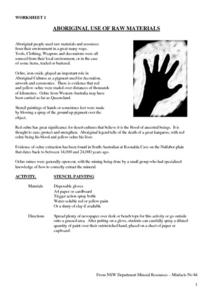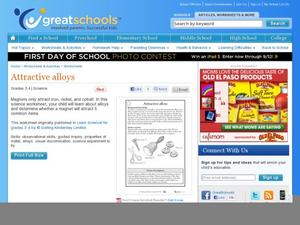Teach Engineering
May the Force Be with You: Weight
Too much material will weigh you down. The sixth segment in a series of 22 highlights how weight affects a plane. Pupils learn that engineers take the properties of materials, including weight, when designing something.
Royal Society of Chemistry
Alloys
What are alloys, and why do we use them? Through a series of interactive puzzles, scholars examine the components and uses of several common alloys. The accompanying teacher's resources provide support in using the lesson, printable...
Teach Engineering
Alloy Advantage
Mix it up by using an intriguing resource that teaches young metallurgists that alloys are a metal mixture. They learn about the advantages of using alloys over pure metals and investigate titanium alloys as an example to finish the...
Teach Engineering
Alloy the Way to Mars
Future engineers test different alloys to determine the specific strength of each one. Based on the results, they make a recommendation to NASA on which alloy to use on engines for spacecraft.
Science Geek
Metallic Bonding
Introduce your class to metallic bonding with a presentation that covers packing in metals, substitutional alloys, interstitial alloys, and properties of metals.
It's About Time
Metals and Nonmetals
Did you know you can melt the metal gallium with just the heat of your hand? Pupils observe and test materials in order to classify them as metal or non-metal. A reading passage and analysis questions wrap up the lesson.
NSW Department Mineral Resources
Aboriginal Use of Raw Materials
What's the difference between base metals and precious metals? Experimenting with natural metals is an interesting way for kids to learn about the world around them. Use a resource that contains over 30 pages of worksheets and...
Brooklyn Children’s Museum
Rocks and Minerals in Our Lives
Young geologists discover the important role that rocks and minerals play in our everyday lives through this series of hands-on activities. Starting off with a lesson that defines the difference between plants, animals, and...
Curated OER
Attractive Alloys
Include a lab about alloys and magnets in your fourth grade science lesson. Young scientists read the necessary background knowledge about alloys, then choose which objects (a screw, a bell, scissors, or coins) will be attracted to...
Curated OER
Chapter 12 Review, Section 1: Solutions
Here is a different approach to solutions: a worksheet that has chemistry learners use words to describe them! This is an outstanding exercise that will stretch learners to show what they know. They answer questions comparing solutions,...
Curated OER
Why and How Atoms Combine
Here is a top-notch handout to supply your chemistry class with. It covers valence electrons, Lewis diagrams, the octet rule, and more! Technically it is less of a worksheet than a detailed explanation of these chemical bonding concepts....
Curated OER
Alloys
Tidy slides and lecture notes for each are included in this presentation on alloys. Instruction begins with the molecular arrangement of a pure element, gold, and progresses to a few example alloys: brass, steel, and nitinol. This...
Curated OER
Density of Pennies Lab
In this density of pennies worksheet, student conduct an experiment to determine the metals used in the core of pennies made after 1983. Students design their own experiments using a balance and graph paper to determine the density of...
Curated OER
The Nature of Solutions
In this solutions instructional activity, students compare different types of solutions and distinguish between the solvent and solute in a solution. This instructional activity has 7 matching and 10 short answer questions.
Curated OER
Transition Metals
Students identify and describe transition metals. They discuss alloys and their benefits. Students research one common, alloy, its composition, properties, and uses. They are asked for some common properties of most transition metals....
Curated OER
Deep Thoughts
Students examine what lies within the Earth. They research and create scale models illustrating the layers of the Earth and write skits advocating a travel plan to send a probe into the Earth's mantle.
Curated OER
Solutions Test Review
In this solutions worksheet, students review the most commonly used solvent, give examples of an emulsifying agents and alloys, and use solubility curves to answer questions. This worksheet has 11 fill in the blank, 6 short answer, and...
Curated OER
Aerospace Engineering
Students explore oil field applications of Shape Memory Alloys. For this engineering lesson students divide into groups and research mini research applications then complete a project.
Curated OER
Use of Common Metals
In this metals learning exercise, students read about the different properties of aluminum, copper, and iron and determine why these metals are used they way they are used. This learning exercise has 5 short answer questions.
Curated OER
Properties of Matter
In this matter worksheet, students compare metals and non-metals, elements, and chemical and physical properties. This worksheet has 22 short answer questions.
Curated OER
What is a Solution?
In this solutions worksheet, learners read about how people first learned to use metals and to combine metals to form alloys. Students write an essay telling the story of how ancient people first learned to cause physical changes in metal.
PBS
Pbs Learning Media: Elements of Steel
This resource from the AMERICAN EXPERIENCE Web site, which contains both an interactive activity and illustrated text, looks at the composition of different types of steel and their impact on technology.
TED Talks
Ted: Ted Ed: Magical Metals: How Shape Memory Alloys Work
In this video, Ainissa Ramirez describes what shape memory alloys are, how they work, and how they are used. [4:46] Followed by a short quiz and a list of additional resources to explore.
Royal Society of Chemistry
Royal Society of Chemistry: Gridlocks: Level 1
A collection of grid puzzles that cover topics in basic chemistry, including acids, salts, alkalis, chemistry lab equipment, the periodic table, states of matter, and more. These are excellent for topic review and reinforcement. The...

























